
The Caudron R.4 was a French World War I twin-engine biplane reconnaissance/artillery cooperation aircraft and the progenitor of a series of successful aircraft that filled a variety of roles with the French Aéronautique Militaire.

The Bristol T.B.8, or Bristol-Coanda T.B.8 was an early British biplane built by the Bristol Aeroplane Company and designed by the Romanian Henri Coandă. Fifty four Bristol T.B.8s were built, being mainly used as a trainer. A small number of Bristol T.B.8s were briefly used as bombers at the start of the World War I by the Royal Naval Air Service.

The Bristol Gordon England biplanes were a series of early British military biplane aircraft designed by Eric Gordon England for the Bristol Aeroplane Company that first flew in 1912. Designed for easy ground transport, the aircraft could be quickly disassembled.
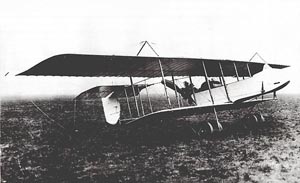
The Farman HF.20 and its derivatives were a family of reconnaissance aircraft produced in France shortly before and during the First World War. It was a refined version of the Farman MF.11 "Shorthorn" that did away with the type's distinctive landing skids, and incorporated design features from Henri Farman's designs. It entered service with the French, Belgian and Serbian armies in 1913, and with the British RFC and RNAS shortly after the outbreak of war. The type was also licence-built in the UK by Airco and Grahame-White.
The Sopwith Two-Seat Scout was a 1910s British biplane Anti-Zeppelin scout biplane designed and built for the Admiralty by the Sopwith Aviation Company. It was nicknamed the Spinning Jenny due to a tendency to enter a spin.

The Lioré et Olivier LeO 20 was a French night-bomber aircraft built by Lioré et Olivier.
The Morane-Saulnier AF, also known as the Morane-Saulnier Type AF and the MoS 28 was a French First World War single-seat biplane fighter prototype from 1917.
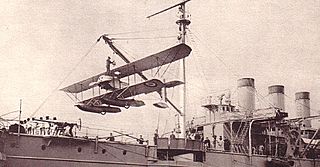
The Caudron J Marine was an amphibious, two-seat, biplane equipped with floats and wheels, similar to the earlier Caudron J floatplane.
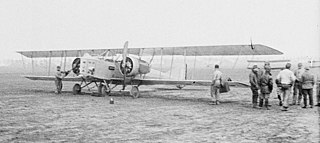
The Morane-Saulnier T was a French biplane reconnaissance aircraft in 1916 and produced in small numbers during World War I.
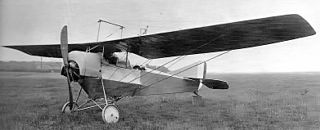
The R.E.P. 'Parasol' Type L was a military reconnaissance aircraft designed and produced in France by Robert Esnault-Pelterie in 1914.

The REP Type N was a military reconnaissance monoplane produced in France in 1914.

The Hansa-Brandenburg W.20 was a German submarine-launched reconnaissance flying boat of the World War I era, designed and built by Hansa-Brandenburg.
The Borel Bo.11 was a French two-seat general purpose monoplane designed and built by Etablissements Borel.
The SNCASE SE-400 was a prototype French twin-engined coastal patrol floatplane of the Second World War. A single example was flown, but development was abandoned in May 1940 owing to the German invasion of France.
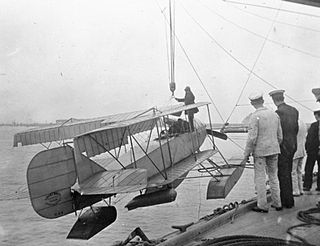
The Short Admiralty Type 81 was a series of British two-seat floatplanes built prior to the First World War, and used by the Royal Naval Air Service in the early years of the war. They were powered by 160 hp (120 kW) Gnome Lambda-Lambda 14 cylinder two-row rotary engines and had folding wings to aid storage on ship, hence the popular name Short Folder, shared with a number of other seaplanes made by Short Brothers.

The Nieuport II was a mid-wing monoplane racing or sport aircraft built by the Société Anonyme des Établissements Nieuport between 1910 and 1914 and was noted for its high performance using a small twin-cylinder engine, and winning many races, primarily in France before being used as a trainer during World War I by French flying schools.
The Goupy Hydroaeroplane was a floatplane developed by Ambroise Goupy in 1912, which was displayed at the 1912 Paris Aero Salon. It was described in Flight as being generally comparable to a Goupy biplane designed by Alphonse Tellier displayed the year before, except for the change from wheels to a pair of pontoon-style floats. Janes 1913 stated that at least one had been built in 1912, and that the company was producing around 30 a year, but actual production numbers are not known beyond the 1912 demonstrator. An editorial review of the 1913 Paris Aero Salon bemoaned the lack of advancement in Goupy designs, with no display of a seaplane.
The Dorand DO.1 was an armoured reconnaissance-bomber designed and built in France from 1913. A small number were used operationally as a stop-gap measure.

The Voisin VII was a French reconnaissance pusher biplane aircraft of World War I.

The Paul Schmitt P.S.7 was a French World War I two-seat biplane bomber that dispensed with the novel variable incidence wing used on prior designs.















